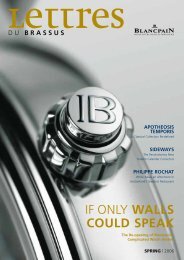THE HISTORY OF BLANCPAIN
THE HISTORY OF BLANCPAIN
THE HISTORY OF BLANCPAIN
Create successful ePaper yourself
Turn your PDF publications into a flip-book with our unique Google optimized e-Paper software.
ART DE VIVRE<br />
“When I was seven I was sent away as a<br />
servant to look after the livestock. We had<br />
enough countryside to live in, but there were<br />
11 of us kids so … no school. Times were<br />
hard, make no mistake! We were always in<br />
the forest, looking for wood to make equipment:<br />
tools, panniers, stalls for the cattle,<br />
roofing shingles, household furniture –<br />
everything was made of wood. In autumn<br />
we gathered leaves to make winter bedding<br />
for the animals. The forest provided everything,<br />
and we made everything by hand.”<br />
After many adventures through the Italian<br />
forests of the Abruzzi – home to wolves and<br />
bears – and the French forests of the Vosges<br />
and the Landes, he ended up in the Joux<br />
Valley. He’s evidently found his heaven-onearth<br />
in the Risoud forest.<br />
“Do you see that little spruce there?” he<br />
asks.<br />
No, I don’t see it. It’s hidden by bracken<br />
twice its height. I could easily have trodden<br />
it flat. Not Lorenzo, despite his heavy boots,<br />
he moves like a cat, careful of the smallest<br />
shoot. He knows every corner of his forest,<br />
finds the small firs and makes them a bed in<br />
which to grow. The forest is his garden.<br />
It takes time to grow into a resonance<br />
spruce. The ones under Lorenzo’s protection<br />
and care today will be felled in three or four<br />
hundred years. The value of the wood from<br />
the Risoud forest is its slow growth in a<br />
harsh climate. Holding back its resources<br />
because of the long, bitter winters, the trees<br />
have a growing season of only two or three<br />
months. This summer, our infant tree has<br />
grown three centimetres. The same species<br />
on the lowland plains would have put on 60<br />
centimetres or more. The difference is apparent<br />
in the grain of the wood. The most<br />
patient of the Risoud spruces end up in the<br />
skilled hands of the violin-maker.<br />
Lorenzo caresses his trees; he measures<br />
them with his arms. He knows more than<br />
anyone about their essential ecological function.<br />
So his voice sometimes turns sad, and<br />
it’s not without asperity that he rails against<br />
those who “no longer understand the for-







